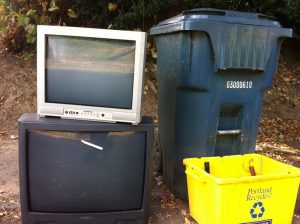
The current regulatory system, however, is based on the idea that if original equipment manufacturers (OEMs) have to pay for recycling, they will find a way to ensure recycling takes place. While this may be true for more modern products, this is not the case for CRTs.
On the surface, CRT glass is most valuable when treated as silica. But silica happens to be one of the most ubiquitous minerals on earth and that means supply of it is abundant. What’s more, the particular blend of silica derived from CRT glass contains toxics – namely lead – that make it far less attractive to recover and reuse.
Shipping such a material to end-of-life outlets on the other side of country or across oceans only adds to the concern of environmental impact.
Recovery versus disposal
Today, the perceived need to find a recycling outlet for leaded CRT glass is causing a major backlog of this material and leading to the abandonment of millions of pounds of CRT material all over the U.S.
Some in the industry point to “viable” CRT solutions, including dilution, zinc smelting, the introduction of lead in non-toxic products and using CRT glass as filler in ordinarily non-toxic manufacturing processing. Others argue the primary smelting industry could accept the glass and recover the lead.
But it is irresponsible to introduce lead into products or processes that do not need its presence. Whether in ceramic tiling or simply using the glass as filler in concrete, the presence of the CRT glass is not required and not beneficial. Alleviating the e-scrap industry’s current CRT problem only to create a lead abatement problem down the road is unconscionable.
Landfilling as responsible management
That’s why responsible disposal should be considered as an option. The landfill industry is more financially stable in the long term than the e-scrap industry. Moreover, landfills are accustomed to navigating the specifics of the federal Resource Conservation and Recovery Act, which regulates handling of hazardous and non-hazardous solid waste.
To be sure, much discussion is still needed about the chemical treatment and productive reuse of CRT glass within the landfill setting. However, the landfill option can no longer be dismissed out of hand simply because disposal is involved. And as is being demonstrated by newer ideas such as mineable cell technology, the landfill solution does not necessarily have to end in disposal.
The e-scrap industry’s current approach to handling CRT glass is risk-intensive and often reckless. Should conditions continue in this manner, the industry will lose future risk control options.
For example, if insurance companies are continuously asked to become involved and incur expenses for cleanups resulting from poor behavior – even if only to relieve themselves of a legal duty – the insurance market will react. This reaction will preclude any thoughtful cooperation between the insurance and e-scrap industries to work for a risk solution viable to all involved.
Without at least the option of risk transfer, both the e-scrap and real estate industries will continue to place personal and business assets at risk. The landfill solution should be discussed because it provides finite risk for all stakeholders, certainty for OEMs and longevity for the e-scrap industry.
On the other hand, continuing to dismiss disposal options will create ripple effects through the rest of the e-scrap industry and continue to complicate and delay action on a solvable, short-term problem.
Ross Fields is a risk professional at San Diego-based Leavitt Group, and he specializes in risk management to the solid waste industry. He can be contacted at ross-fields@leavitt.com.
Doug Smith is the director of corporate environment, safety and health for Sony Electronics. He can be contacted at douglas.smith@am.sony.com.
The views and opinions expressed are those of the author and do not imply endorsement by Resource Recycling, Inc. If you have a subject you wish to cover in a future Op-Ed, please send a short proposal to news@resource-recycling.com for consideration.